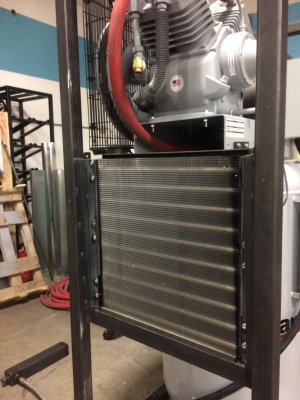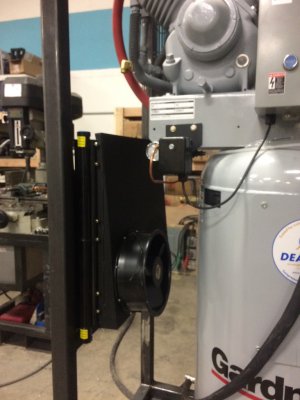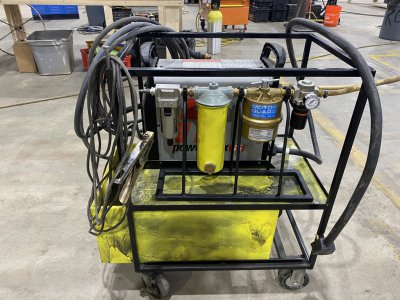- Joined
- May 7, 2020
- Messages
- 267
We should be getting our CNC plasma table in September so we're getting the shop ready. Plasma cutters like clean, dry air and compressors like to make water. After about a zillion YouTube videos we had our shopping list.
For those unfamiliar I'll describe, maybe oversimplify, the water problem. Compressed air cannot hold as much water vapor, at a given temperature, as air at ambient pressure. At about 100 psi, air can hold only about 1/8th as much water in the form of vapor. While compression heats the air and offsets that effect to some extent, once the air in the tank cools down water will condense out and pool at the bottom. That's why you need to drain your compressor tank. Even then, you'll still have water in your air lines. Plasma cutters will eat consumables, paint will get fisheyes, tools can rust. Not great.
One strategy to solve the water issue is to use a compressor after-cooler. Lots of different ways to do it but the gist is to cool the hot air coming from the compressor pump before it goes into the tank.
I chose to go with a fan-cooled radiator for this purpose. It is compact, cheap and effective.
Looks like the most popular radiator for this task is the Derale 15300 available on Amazon. Comes with size 8 AN connectors which aren't too restrictive and this model has a max operating pressure of 250 psi so it should hold up well with compressed air (but YMMV as these are pretty cheap).
The compressor pump will be connected to the top AN fitting (gravity feed when the water condenses).
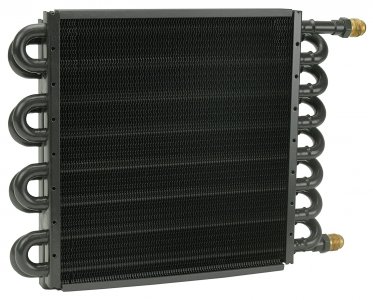
The next component is an in-line water separator. The THB brand 1/2" Water Separator with Automatic Drain seems to be quite popular since it has a float type drain. Available on Amazon. Unlike some, this one will empty when full even though under pressure. Good choice for this application.
The bottom AN fitting of the radiator runs to the water trap. Since the air is now cool and still pressurized, water vapor will condense and will settle in the moisture trap keeping it out of the tank. Or at least that's the idea.
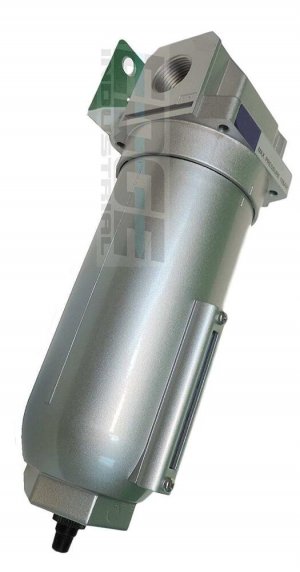
The next component is the 10" cooling fan. Most everyone is buying cheap radiator fans on Amazon or Ebay. Got this one because, well, how can you argue with a fan made by MOSTPLUS. There are seemingly 742 brands of the same basic fan. All cheap. This one was reviewed by a company that runs it 24/7 and it lasts for 6 months each time. For our application, that is longer than we'll be in this shop so it should work perfectly. Forced air through the Derale radiator pulls some serious BTUs out of the air line.
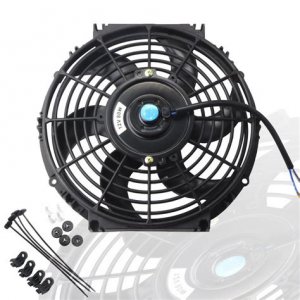
Finally, we needed to run power to the fan when the compressor was running. You can find these PC power supplies on Amazon for dirt cheap.
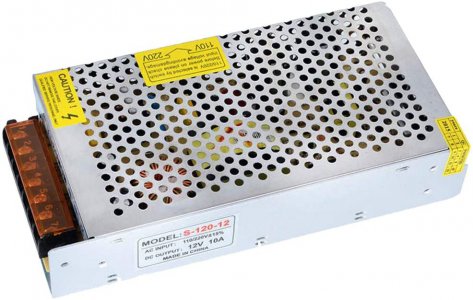
This Joylit 12V 10 amp runs on either 120/240. Attached under the compressor pump mounting plate via industrial adhesive tape. Very easy to wire into the contactor on the compressor. Runs the fan when the compressor runs. Easy peasy.
To put this all together we needed two things, 1) plumbing and 2) some structure.
Time to remove the original plumbing (which is super simple but man did we get a lot of water in the tank). You can see that we started replacing pipe fittings/compression fittings with AN fittings
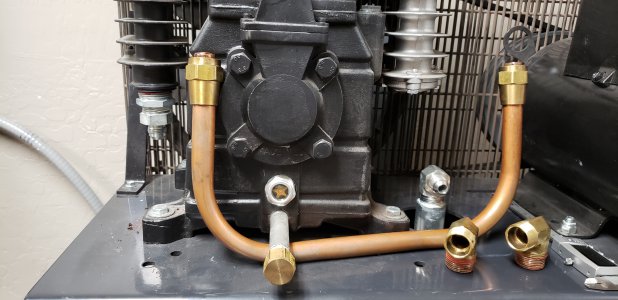
I will give a shout out to Hose Power (a Bridgestone company). We have three locations in Phoenix - seems like a national chain. These guys make industrial hoses to order. Very affordable for what it is. I went with braided stainless/PTFE rated to 500 degrees. Spec'd with AN fittings, it is a really clean, easy install. Most folks are bending copper which works of course. Just more of a hassle trying to connect from AN to something you can use with Copper tubing. And in the back of my mind, sending more vibes to a cheap radiator through rigid copper pipe doesn't seem optimal.
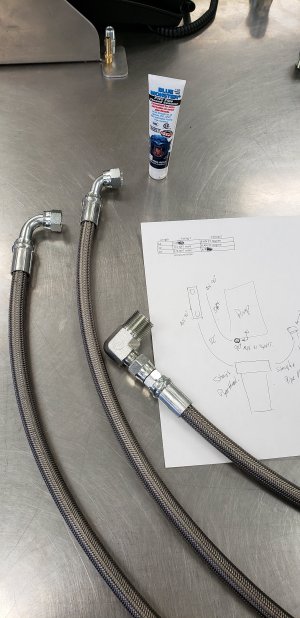
Armed with hoses, we needed to fab up a mount for the radiator.
A lot of folks just hang the radiator on the mesh guard behind the compressor pully/fan. Not a lot of CFM seems to me - more of a gentle breeze. Big air gap. Really wanted something moving more air and generating more pressure through the cooling fins. We planned a wall mount and with some cowboy engineering we built this:
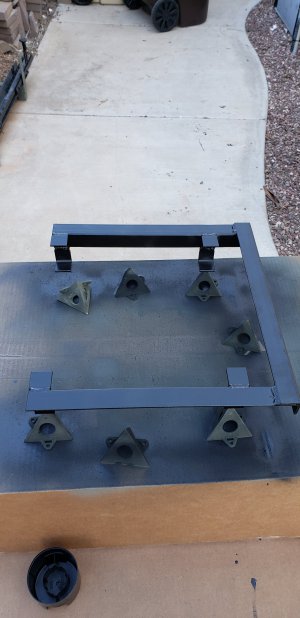
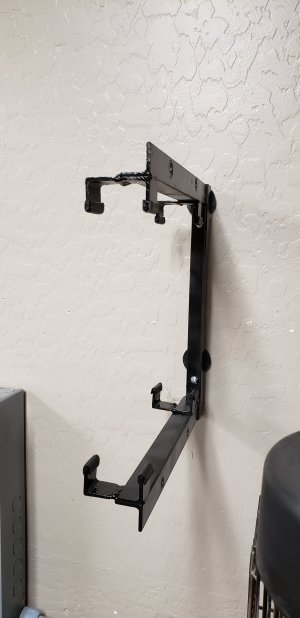
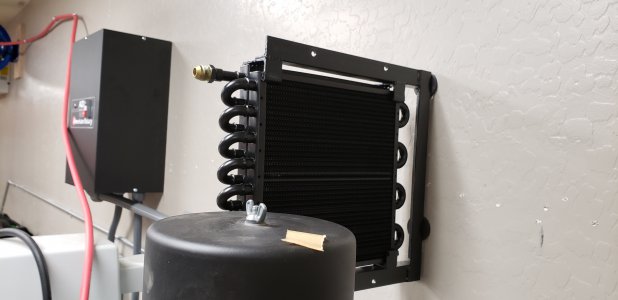
This is a piece of wall space that can't really be used for much else. Radiator fits great. We used rubber car door trim on the brackets and some foam pads underneath to insulate and protect the radiator a bit - some vibration still comes through that stiff hose.
This is the after-cooler with plumbing attached:
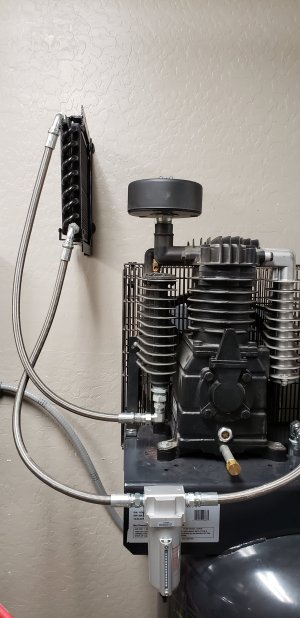
A lot of folks want to keep everything inside of the original compressor footprint. I get it. This is still very space efficient and the orientation keeps the install pretty clean I think.
Finally, mounted the fan to the radiator. Pretty happy with how this turned out. Notice the tight seal. We should be getting some good air flow/heat transport. Those t-slot mounting brackets allow you to slide the fan to be flush with the radiator fins. We did a pull (you can reverse polarity and push) since the radiator is facing cooler air conditioned air.
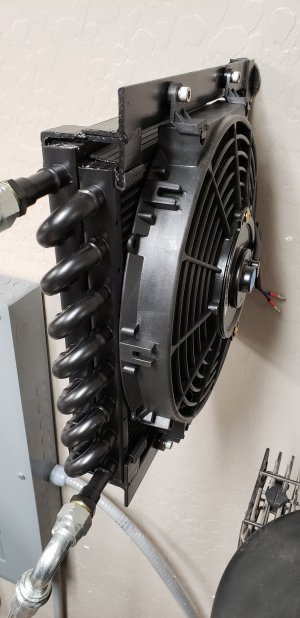
First test complete, which if you are sharp eyed you'll realize didn't involve using the MOSTPLUS (not wired yet). I just held up a Vornado in front of the radiator. I'm really impressed with the temperature differential. The input air fitting is blistering hot and the outlet line is essentially ambient temperature when it hits the tank.
I'll post Part 2 showing the air distribution system and the other components we're using to get dry air to our plasma cutter.
Here's a preview - this holds more desiccant than that last bag of beef jerky you bought.
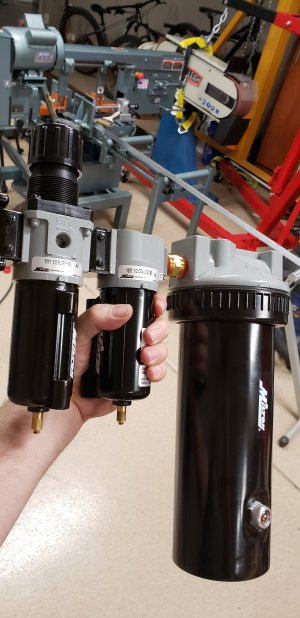
Hope this helps answer some questions and serves as a little inspiration.
~~~~~~
8/28 update: tank sat overnight and still no mist coming out the drain valve. Pretty cool.
~~~~~~
8/30 update: if you really crack open the tank drain you get a little mist. After doing more homework - the air in a compressor tank is right at 100% humidity given the higher dew point of pressurized air. The after-cooler just dumps the condensate before entering the tank (a very good thing for the tank). Rapid depressurization will cause some condensation in the vented air even with the after-cooler. The real draw in using an after-cooler is keeping water out of your air when the pump is running as in a long CNC plasma cutting session - lots of parts on a 4x8 plate for instance. The air is back to ambient once it hits the tank and even with the pump running you have much less water for a desiccant dryer or even a refrigerant dryer to deal with. Good stuff for your consumables life and for cut quality. And if you use PEX lines like I did, you'll not see the degradation caused by excessive air temps.
For those unfamiliar I'll describe, maybe oversimplify, the water problem. Compressed air cannot hold as much water vapor, at a given temperature, as air at ambient pressure. At about 100 psi, air can hold only about 1/8th as much water in the form of vapor. While compression heats the air and offsets that effect to some extent, once the air in the tank cools down water will condense out and pool at the bottom. That's why you need to drain your compressor tank. Even then, you'll still have water in your air lines. Plasma cutters will eat consumables, paint will get fisheyes, tools can rust. Not great.
One strategy to solve the water issue is to use a compressor after-cooler. Lots of different ways to do it but the gist is to cool the hot air coming from the compressor pump before it goes into the tank.
I chose to go with a fan-cooled radiator for this purpose. It is compact, cheap and effective.
Looks like the most popular radiator for this task is the Derale 15300 available on Amazon. Comes with size 8 AN connectors which aren't too restrictive and this model has a max operating pressure of 250 psi so it should hold up well with compressed air (but YMMV as these are pretty cheap).
The compressor pump will be connected to the top AN fitting (gravity feed when the water condenses).

The next component is an in-line water separator. The THB brand 1/2" Water Separator with Automatic Drain seems to be quite popular since it has a float type drain. Available on Amazon. Unlike some, this one will empty when full even though under pressure. Good choice for this application.
The bottom AN fitting of the radiator runs to the water trap. Since the air is now cool and still pressurized, water vapor will condense and will settle in the moisture trap keeping it out of the tank. Or at least that's the idea.

The next component is the 10" cooling fan. Most everyone is buying cheap radiator fans on Amazon or Ebay. Got this one because, well, how can you argue with a fan made by MOSTPLUS. There are seemingly 742 brands of the same basic fan. All cheap. This one was reviewed by a company that runs it 24/7 and it lasts for 6 months each time. For our application, that is longer than we'll be in this shop so it should work perfectly. Forced air through the Derale radiator pulls some serious BTUs out of the air line.

Finally, we needed to run power to the fan when the compressor was running. You can find these PC power supplies on Amazon for dirt cheap.

This Joylit 12V 10 amp runs on either 120/240. Attached under the compressor pump mounting plate via industrial adhesive tape. Very easy to wire into the contactor on the compressor. Runs the fan when the compressor runs. Easy peasy.
To put this all together we needed two things, 1) plumbing and 2) some structure.
Time to remove the original plumbing (which is super simple but man did we get a lot of water in the tank). You can see that we started replacing pipe fittings/compression fittings with AN fittings

I will give a shout out to Hose Power (a Bridgestone company). We have three locations in Phoenix - seems like a national chain. These guys make industrial hoses to order. Very affordable for what it is. I went with braided stainless/PTFE rated to 500 degrees. Spec'd with AN fittings, it is a really clean, easy install. Most folks are bending copper which works of course. Just more of a hassle trying to connect from AN to something you can use with Copper tubing. And in the back of my mind, sending more vibes to a cheap radiator through rigid copper pipe doesn't seem optimal.

Armed with hoses, we needed to fab up a mount for the radiator.
A lot of folks just hang the radiator on the mesh guard behind the compressor pully/fan. Not a lot of CFM seems to me - more of a gentle breeze. Big air gap. Really wanted something moving more air and generating more pressure through the cooling fins. We planned a wall mount and with some cowboy engineering we built this:



This is a piece of wall space that can't really be used for much else. Radiator fits great. We used rubber car door trim on the brackets and some foam pads underneath to insulate and protect the radiator a bit - some vibration still comes through that stiff hose.
This is the after-cooler with plumbing attached:

A lot of folks want to keep everything inside of the original compressor footprint. I get it. This is still very space efficient and the orientation keeps the install pretty clean I think.
Finally, mounted the fan to the radiator. Pretty happy with how this turned out. Notice the tight seal. We should be getting some good air flow/heat transport. Those t-slot mounting brackets allow you to slide the fan to be flush with the radiator fins. We did a pull (you can reverse polarity and push) since the radiator is facing cooler air conditioned air.

First test complete, which if you are sharp eyed you'll realize didn't involve using the MOSTPLUS (not wired yet). I just held up a Vornado in front of the radiator. I'm really impressed with the temperature differential. The input air fitting is blistering hot and the outlet line is essentially ambient temperature when it hits the tank.
I'll post Part 2 showing the air distribution system and the other components we're using to get dry air to our plasma cutter.
Here's a preview - this holds more desiccant than that last bag of beef jerky you bought.

Hope this helps answer some questions and serves as a little inspiration.
~~~~~~
8/28 update: tank sat overnight and still no mist coming out the drain valve. Pretty cool.
~~~~~~
8/30 update: if you really crack open the tank drain you get a little mist. After doing more homework - the air in a compressor tank is right at 100% humidity given the higher dew point of pressurized air. The after-cooler just dumps the condensate before entering the tank (a very good thing for the tank). Rapid depressurization will cause some condensation in the vented air even with the after-cooler. The real draw in using an after-cooler is keeping water out of your air when the pump is running as in a long CNC plasma cutting session - lots of parts on a 4x8 plate for instance. The air is back to ambient once it hits the tank and even with the pump running you have much less water for a desiccant dryer or even a refrigerant dryer to deal with. Good stuff for your consumables life and for cut quality. And if you use PEX lines like I did, you'll not see the degradation caused by excessive air temps.
Last edited:

